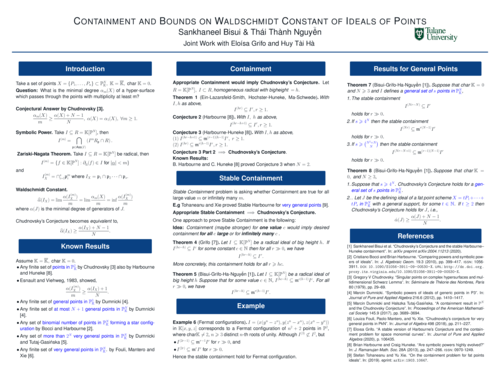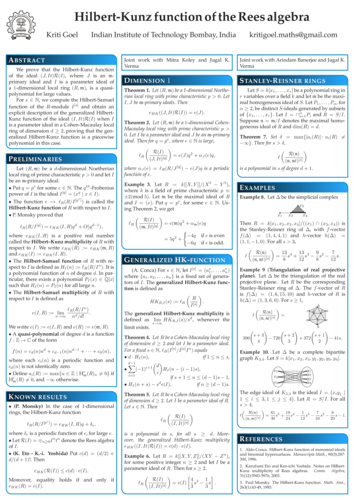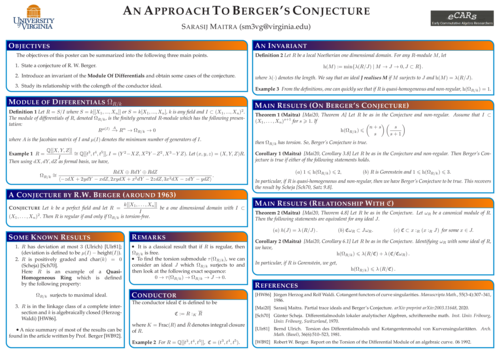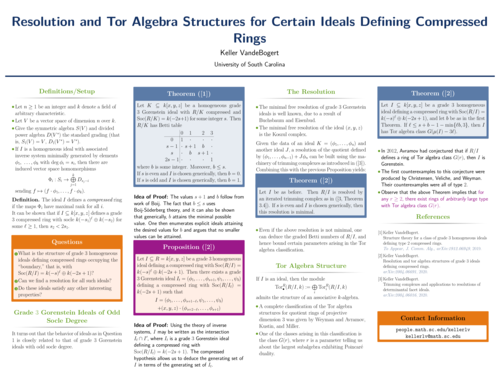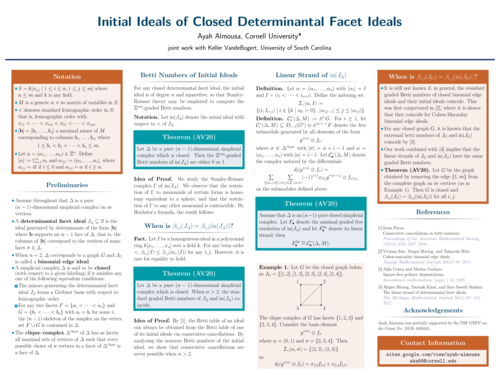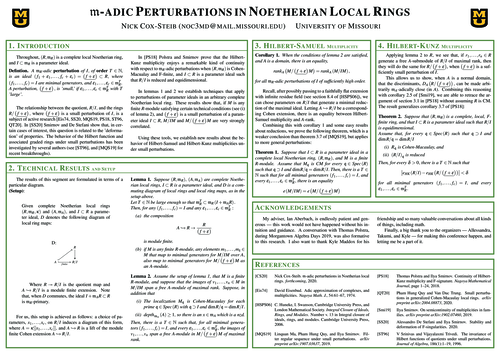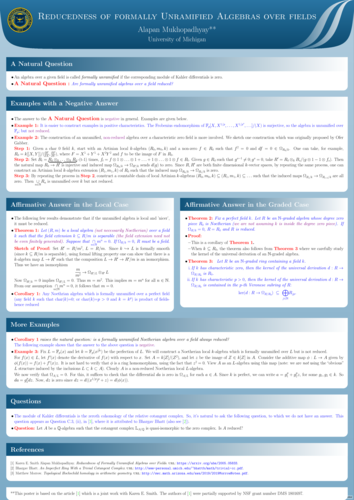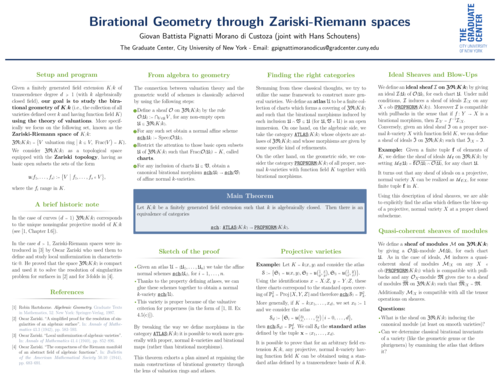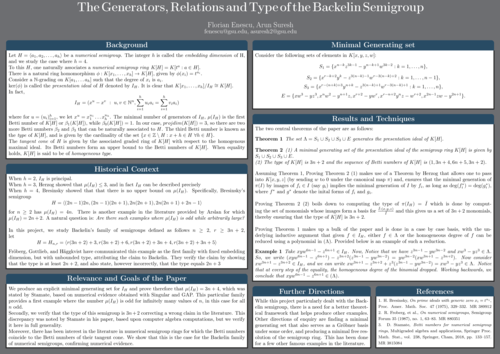The eCARs virtual poster session is a chance for graduate students to present their research to attending professors, postdocs, and graduate students. There will be a poster session on Saturday and on Sunday with different sets of posters.
Poster presenters will be given 4–5 minutes to present a short "elevator pitch" for their poster to the audience, and then break out into rooms where the audience can ask questions of the presenters. You can view their posters ahead of time below.
Saturday
Sankhaneel Bisui - Containment and Bounds on Waldschmidt Constant of Ideals of Points
In this poster, we present some bounds on the Waldschmidt constant and containment between symbolic and ordinary powers of the defining ideals of points in projective spaces. We also provide Chudnovsky's Conjecture for a general set of sufficiently many points and for fat point schemes. The results are from joint work with Eloísa Grifo, Tài Hà and Thái Thành Nguyên. arXiv:2004.11213
Kriti Goel - Hilbert-Kunz function and Hilbert-Kunz multiplicity of Rees algebra
We prove that the Hilbert-Kunz function of the ideal \((I, It)\) of the Rees algebra \(R(I)\), where \(I\) is an \(m\)-primary ideal of a 1-dimensional local ring \((R,m)\), is a quasi-polynomial in \(e\), for large \(e\). We calculate the Hilbert-Samuel function of the \(R\)-module \(I^{[s]}\) and obtain an explicit description of the generalized Hilbert-Kunz function of the ideal \((I, It)R(I)\) when \(I\) is a parameter ideal in a Cohen-Macaulay local ring of dimension at least 2, proving that the generalized Hilbert-Kunz function is a piecewise polynomial in this case. In particular, when \(R\) is the face ring of a simplicial complex and \(R(n)\) is the Rees algebra of the maximal homogeneous ideal \(n\) of \(R\), we show that the generalized Hilbert-Kunz function \(HK(s) = l(R(n)/(n, nt)^{[s]})\) is given by a polynomial for all large \(s\). We illustrate the results with examples and also provide a Macaulay2 code for computing \(HK(s)\). arXiv:1911.03889
Sarasij Maitra - Partial Trace Ideals and Berger's Conjecture
We study colengths of isomorphic copies of an ideal in a one dimensional complete local domain containing a field. The study was motivated by a proof of a particular case of Berger's conjecture by Scheja. Our result generalizes his proof. We further establish links between 'minimum colength of an ideal' with the colength of the conductor ideal up to multiplication by the canonical ideal. arXiv:2003.11648
Keller VandeBogert - Minimal Free Resolutions and Tor Algebra Structures of Certain Compressed Rings
We study certain grade 3 homogeneous ideals defining compressed rings. These ideals are obtained as so-called iterated trimmings of grade 3 Gorenstein ideals; as a consequence, the generic behavior of these ideals is largely determined by the generic behavior of grade 3 Gorenstein ideals defining compressed rings with odd socle degree. Using this structure, we construct an explicit free resolution of all such ideals which is minimal for generically chosen ideals. In the type 2 case, this allows us to give explicit, sharp bounds for parameters arising in the Tor algebra classification. In general, we are able to produce ideals of arbitrarily large type of Tor algebra class \(G(r)\), for any \(r > 1\). In particular, this yields a new class of counterexamples to a previous conjecture of Avramov. arXiv:1912.06949, arXiv:2004.06691
Sunday
Ayah Almousa - Resolutions of Initial Ideals of Closed Determinantal Facet Ideals
We study resolutions of initial ideals of closed determinantal facet ideals with respect to standard lexicographic order. We show that the multigraded Betti numbers of these ideals are always \(0\) or \(1\), regardless of the characteristic of the field. In addition, we show that the standard graded Betti numbers of closed determinantal facet ideals and their initial ideals coincide when generators of the ideal come from maximal minors of a generic \(n\times m\) matrix with \(n>2\). We show that the Betti numbers of a certain closed determinantal facet ideal and its initial ideal coincide, verifying a conjecture of Ene, Herzog, and Hibi in a new case. We give explicit differentials for the linear strand of the initial ideal with respect to standard lexicographic order of an arbitrary closed determinantal facet ideal. This is joint work with Keller VandeBogert. arXiv:2006.14434
Nicholas Cox-Steib - \(\mathfrak{m}\)-adic Perturbations in Noetherian Local Rings
Suppose \((R, \mathfrak{m}_R)\) is a Noetherian local ring, that \(I \subset R\) is an ideal, and that \(M\) is a finite \(R\)-module. We introduce techniques to study the relationship between \(M/IM\) and quotients of the form \[M/(f_1+\epsilon_1, \dots, f_c+\epsilon_c)M,\] where \((f_1, \dots, f_c) = I\) are minimal generators, and \(\epsilon_1, \dots, \epsilon_c \in \mathfrak{m}_R^T\) are in a 'large' power of the maximal ideal. Applications include new results about Hilbert Samuel multiplicities and the \(\mathfrak{m}_R\)-adic continuity of Hilbert-Kunz multiplicity.
Alapan Mukhopadhyay - Reducedness of formally unramified algebras of fields
A finitely generated algebra over a field which is formally unramified over the same field must be reduced. We shall generalize this result to some natural local and graded context, where the algebra need not be finitely generated over the field. We shall provide examples (including one due to Gabber) to show that it is not possible to generalize these results further. arXiv:2005.05833
Giovan Battista Pignatti Morano di Custoza - Birational Geometry through Valuation Rings
The Zariski-Riemann space of a finitely generated field extension \(K/k\), denoted by \(\mathfrak{ZR}(K/k)\), is the collection of all the valuation rings between \(k\) and \(K\). In a series of papers between 1939 and 1944 Zariski proved the compactness of the Zariski-Riemann space by realizing it as the inverse limit of all projective models of \(K/k\); he then used this fact to give a local solution to the problem of resolution of singularities of algebraic varieties. In this talk we will create a category using ad-hoc coverings of \(\mathfrak{ZR}(K/k)\) and we will show it is equivalent to the category of proper normal varieties defined over \(k\) and with function field \(K\). Once this connection is established, we seek to reinterpret modern birational geometry using the purely algebraic language of valuation rings. This is joint work with my advisor Hans Schoutens.
Arun Suresh - The Generators, Relations and Type of the Backelin Semigroup
In this paper, we study Backelin's family
of semigroups defined as follows: \[H = \langle r(3n+2)+3, \
r(3n+2)+6, \ r(3n+2)+3n+4, \ r(3n+2)+3n+5 \rangle,\] with \(n
\geq 2\), \(r \geq 3n +2\). Fröberg, Gottlieb and Häggkvist have
communicated this example as the first family with fixed
embedding dimension, but with unbounded type, attributing the
claim to Backelin.
We produce an explicit minimal generating set for the
presentation ideal \(I_H\) and prove therefore that \(\mu(I_H) =
3n+4\), which was stated in a previous work by Stamate, based on
numerical evidence obtained with Singular and GAP. In
particular, this family provides a first example where
\(\mu(I_H)\) is odd for infinitely many values of \(n\).
Secondly we verify, in full generality, that the type of this
semigroup is \(3n+2\), correcting a wrong claim in the
literature. Moreover, there has been interest in the literature
in numerical semigroup rings for which the Betti numbers
coincide to the Betti numbers of their tangent cone. We show
that this is the case for the Backelin family of numerical
semigroups, confirming existing numerical evidence.
